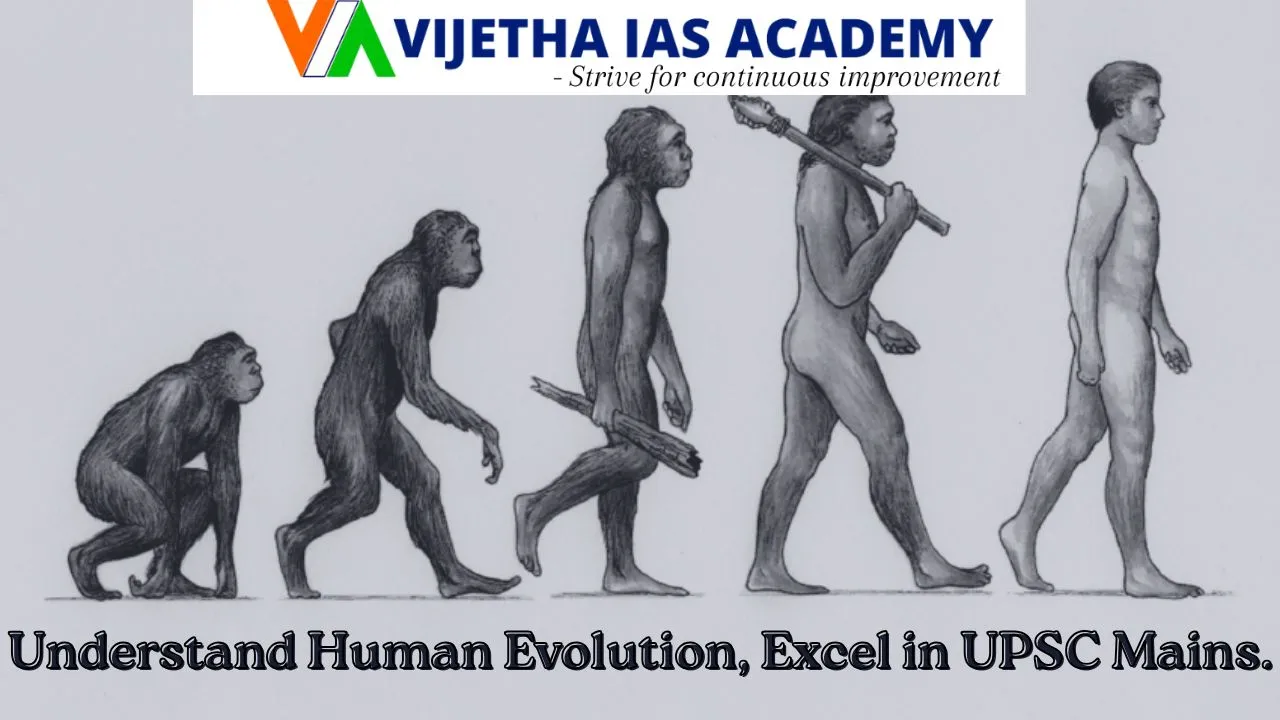
Human Evolution and Emergence of Man – UPSC Anthropology Notes
Introduction
Human evolution is one of the most fascinating and important topics in Anthropology Optional for UPSC. It explains how humans evolved biologically and culturally over millions of years. The journey from simple primates to modern Homo sapiens is a story of mutations, natural selection, cultural growth, and bio-cultural interactions.
This article provides a detailed yet simplified explanation of major theories, evidence, and cultural stages of human evolution – important for Anthropology Optional UPSC preparation.
Factors in Human Evolution
- Mutations – Sudden heritable changes that create new traits.
- Natural Selection – Survival of the fittest, as proposed by Charles Darwin.
- Recombination – Genetic reshuffling that creates diversity.
Pre-Darwinian, Darwinian, and Post-Darwinian Views
Lamarck’s Theory – Inheritance of Acquired Characters
- Jean Baptiste de Lamarck, a French biologist, gave this theory.
- Key principles:
- Internal Vital Force (élan vital)
- Effect of environment and new needs
- Use and disuse of organs
- Inheritance of acquired characters
- Internal Vital Force (élan vital)
- Examples: Evolution of giraffe’s long neck, disappearance of snake limbs, webbed feet of ducks.
Criticism: Experiments by Weismann proved acquired characters are not inherited.
Darwin’s Theory – Natural Selection
- Based on his studies at Galapagos Islands.
- Influenced by Malthus’s theory of population.
- Key postulates:
- Overproduction of species
- Struggle for existence (intra-, inter-, and environmental struggle)
- Variations among individuals
- Natural selection ensures survival of the fittest
- Gradual speciation
- Overproduction of species
Criticism: Darwin couldn’t explain the source of variations and heredity.
Mutation Theory – Hugo de Vries
- Based on evening primrose experiments.
- Mutations are sudden, heritable, and form new species.
- Criticism: Later studies showed evolution is not only mutation-driven but a combination of gradual changes and genetic variation.
Modern Synthetic Theory (Neo-Darwinism)
- Proposed by Julian Huxley and others.
- Combines Darwin’s natural selection with genetics, paleontology, ecology, and other fields.
- Today’s accepted explanation of evolution.
Key Evolutionary Rules
- Dollo’s Rule: Evolution is irreversible; structures once lost do not reappear in the same form.
- Cope’s Rule: Many lineages show a tendency to increase in size over time.
- Gauss’s Rule (Competitive Exclusion Principle): No two species can permanently occupy the same ecological niche.
Adaptive Evolution
- Parallelism (Homologous Evolution): Related species evolve similar structures due to common ancestry (e.g., forelimbs of humans, bats, and whales).
- Convergent Evolution (Analogous Evolution): Unrelated species evolve similar adaptations due to environment (e.g., wings of birds, bats, and insects).
- Adaptive Radiation: A single ancestral stock evolves into diverse forms to adapt to different environments (Darwin’s finches are the best example).
Mosaic Evolution
- Evolution does not occur uniformly in all parts of the body.
- Some organs evolve earlier than others.
- Example: Human bipedalism evolved before brain expansion.
Emergence of Modern Man
Human evolution is both biological and cultural.
Biological Factors
- Food collection
- Hunting and group coordination
- Prolonged infant dependency
- Control of fire
- Development of language
Cultural Factors
- Tool-making (Oldowan, Acheulian, Mousterian, Blade, Microlithic, Neolithic cultures)
- Discovery of fire, cooking food, and social bonding
- Language and writing systems
- Marriage, customs, and division of labour
Result: Culture accelerated human evolution – making us the most adaptive species on Earth.
Tools and Cultural Evolution
- Lower Palaeolithic – Homo habilis (Oldowan tools), Homo erectus (Acheulian hand axes).
- Middle Palaeolithic – Neanderthals (Mousterian flake tools).
- Upper Palaeolithic – Homo sapiens (blade tools, burins, arrowheads).
- Mesolithic – Microlithic culture with geometrical stone tools.
- Neolithic – Polished stone tools, agriculture, permanent settlements.
- Bronze and Iron Age – Development of metallurgy, urbanization, and early civilizations.
Bio-Cultural Evolution
The most important phase of human evolution is the interaction between biology and culture.
- Fire extended working hours, ensured safety, and promoted social gatherings.
- Cooked food reduced strain on jaws and teeth.
- Language and script helped store and transmit knowledge.
- Tool-making and brain expansion developed together.
- Male-female bonding, division of labour, and early marriage systems evolved.
Importance for UPSC Anthropology
- Questions on Lamarck, Darwin, and Modern Evolutionary Theory are regularly asked in UPSC Mains (Anthropology Paper I).
- Cultural evolution (stone tools, fire, bio-cultural evolution) is important for both Paper I & II.
- Answer writing should include examples, diagrams, and case studies.
Conclusion
Human evolution is not just a biological process – it is a bio-cultural journey that shaped us into modern humans. For UPSC aspirants with Anthropology optional, mastering this topic is essential to score high in Mains.
Preparing Anthropology Optional for UPSC?
Join Vijetha IAS Academy Delhi – India’s trusted name in Anthropology Optional Coaching & Test Series.
- Comprehensive classroom coaching
- Online & offline Anthropology test series
- Personalized mentorship & evaluation
- Proven track record of toppers
Visit Vijetha IAS Academy Delhi OR
Enroll in Anthropology Test Series Online from anywhere in India.
Admissions Open for 2026 Batch – Limited Seats!
